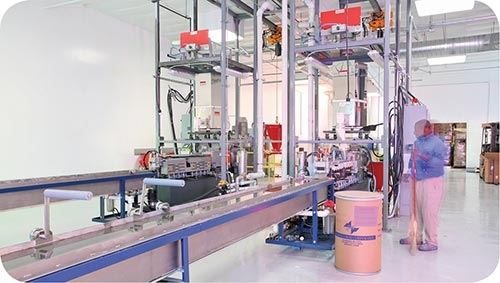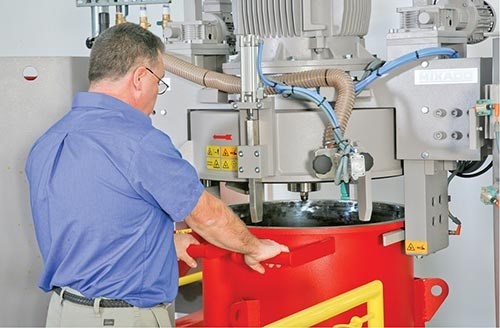A Pioneer in ‘Clean Compounding’
When Plastics Color Corp., based in Calumet City, Ill., established a new compounding plant in Southern California, the firm decided this couldn’t be an ordinary color/additive masterbatch facility.
When Plastics Color Corp., based in Calumet City, Ill., established a new compounding plant in Southern California, the firm decided this couldn’t be an ordinary color/additive masterbatch facility. The new PCC plant in Sun Valley opened in January and is aimed at a regional clientele consisting largely of makers of food and pharmaceutical packaging and medical devices. Such customers ensure high levels of cleanliness and purity in their own products, so it made sense that they would want the same care to be taken in producing masterbatches that go into their products.
As there are no standards yet for “clean compounding,” PCC had to chart its own course, helped by suggestions from customers. Sun Valley was to be PCC’s first top-to-bottom “clean” facility, but it could draw on its experience in establishing a “plant-within-a-plant” clean operating area at its plant in Asheboro, N.C., in 2009. A team from Asheboro was brought to Sun Valley, led by project engineering manager Alan Abrams, who designed the new plant.
The 30,000-ft² plant currently has two Coperion twin-screw compounding lines capable of 1 million lb/yr, though there’s room to quadruple that capacity. Only FDA-approved additives are used here, and no black products (they’re made in Calumet City).
The emphasis on cleanliness at Sun Valley starts with white walls and ceiling, plus 24 skylights that illuminate the plant with nearly twice the brightness of a standard manufacturing facility. Dirt has no place to hide.
The manufacturing area is kept at a positive air pressure, with airlock doors. Employees wear shoe protection and clothing with no cuffs or folds to catch pellets or dirt, and no jewelry. No wood pallets or cardboard are allowed in the production area.
Two of the main technical features of this “clean” plant are filtration for air and process water. All water from the pelletizing lines passes through a 5-micron filter and is exposed to UV light to kill microbes. Plant air is filtered through a water curtain, an evaporative cooling system in which a film of water flows by gravity over a fine mesh. Passing through this curtain, air is cooled and particulates are removed. After startup, the lines run completely automatically. “Hands never touch the material before it is sealed in the bag,” says Joe Byrne, vp of sales and marketing.
An important factor in minimizing raw-materials handling for both cleanliness and efficiency is the use of a Mixaco batch-mixing system. “We used to move materials through the plant in several steps and by hand. Now we weigh, mix, and transport material in the same vessel,” says Byrne. “It’s a single point of contact for raw materials,” adds Abrams. After mixing, the vessel is disengaged from the mixer, covered, and wheeled over to the extrusion line, where it is hoisted up onto a mezzanine atop a gravimetric feeder.
Among other benefits, the mixing bowls can be cleaned easily and comfortably in just 11 min, vs. 45 min for previous mixing systems. “We’re getting that time down even further,” notes Abrams. (Mixaco USA is in Greer, SC; mixaco.com.)
“There’s definitely a ‘Wow’ factor when customers visit this plant,” says Tim Workman, director of business development. “They’ve never seen a compounding plant that looks like this.” He adds that though Sun Valley is not yet a true clean-room facility, “We’re ready to go to the next step when the market demands it.”
Related Content
A Simpler Way to Calculate Shot Size vs. Barrel Capacity
Let’s take another look at this seemingly dull but oh-so-crucial topic.
Read MoreAre Your Sprue or Parts Sticking? Here Are Some Solutions
When a sprue or part sticks, the result of trying to unstick it is often more scratches or undercuts, making the problem worse and the fix more costly. Here’s how to set up a proper procedure for this sticky wicket.
Read MoreWhy (and What) You Need to Dry
Other than polyolefins, almost every other polymer exhibits some level of polarity and therefore can absorb a certain amount of moisture from the atmosphere. Here’s a look at some of these materials, and what needs to be done to dry them.
Read MoreSolve Four Common Problems in PET Stretch-Blow Molding
Here’s a quick guide to fixing four nettlesome problems in processing PET bottles.
Read MoreRead Next
How Polymer Melts in Single-Screw Extruders
Understanding how polymer melts in a single-screw extruder could help you optimize your screw design to eliminate defect-causing solid polymer fragments.
Read MoreTroubleshooting Screw and Barrel Wear in Extrusion
Extruder screws and barrels will wear over time. If you are seeing a reduction in specific rate and higher discharge temperatures, wear is the likely culprit.
Read MoreUnderstanding Melting in Single-Screw Extruders
You can better visualize the melting process by “flipping” the observation point so that the barrel appears to be turning clockwise around a stationary screw.
Read More




























